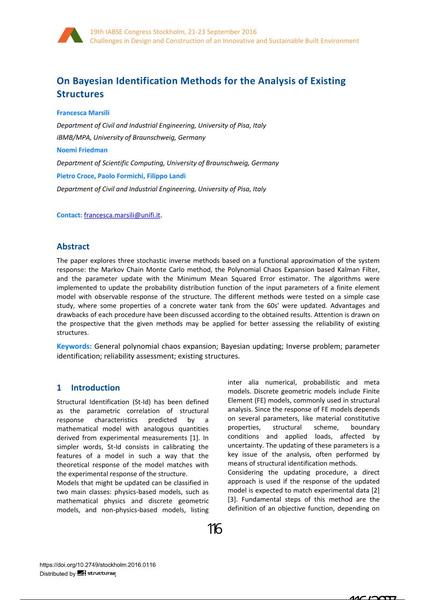On Bayesian Identification Methods for the Analysis of Existing Structures

|
|
|||||||||||
Détails bibliographiques
| Auteur(s): |
Francesca Marsili
(Department of Civil and Industrial Engineering, University of Pisa, Italy; iBMB/MPA, University of Braunschweig, Germany)
Noemi Friedman (Department of Scientific Computing, University of Braunschweig, Germany) Pietro Croce Paolo Formichi (Department of Civil and Industrial Engineering, University of Pisa, Italy) Filippo Landi (Department of Civil and Industrial Engineering, University of Pisa, Italy) |
||||
|---|---|---|---|---|---|
| Médium: | papier de conférence | ||||
| Langue(s): | anglais | ||||
| Conférence: | IABSE Congress: Challenges in Design and Construction of an Innovative and Sustainable Built Environment, Stockholm, Sweden, 21-23 September 2016 | ||||
| Publié dans: | IABSE Congress Stockholm, 2016 | ||||
|
|||||
| Page(s): | 116-123 | ||||
| Nombre total de pages (du PDF): | 8 | ||||
| Année: | 2016 | ||||
| DOI: | 10.2749/stockholm.2016.0116 | ||||
| Abstrait: |
The paper explores three stochastic inverse methods based on a functional approximation of the system response: the Markov Chain Monte Carlo method, the Polynomial Chaos Expansion based Kalman Filter, and the parameter update with the Minimum Mean Squared Error estimator. The algorithms were implemented to update the probability distribution function of the input parameters of a finite element model with observable response of the structure. The different methods were tested on a simple case study, where some properties of a concrete water tank from the 60s' were updated. Advantages and drawbacks of each procedure have been discussed according to the obtained results. Attention is drawn on the prospective that the given methods may be applied for better assessing the reliability of existing structures. |
||||
| Mots-clé: |
structures existantes
|
||||
